Scientists reveal how Mars could turn into a terraformed Dune planet for future colonists
Researchers may soon be inspired by the science fiction story of Dune to transform Mars into a livable and breathing world for humans.
The fictional desert planet Arrakis, which serves as the main setting for Dune, was once a desert wasteland, similar to the Red Planet, but was subsequently transformed into a wet, lush world – but this does not yet happen in the two films released. .
Scientists from NASA and the Pentagon’s Defense Advanced Research Projects Agency (DARPA) have long been working on plans to make Mars a suitable home for future colonists.
These plans include releasing the water trapped in the Earth’s surface, warming the air so the inhabitants don’t freeze to death, and introducing a bacteria to create oxygen – similar to how sandworm metabolism creates breathable air on Dune.
Mars has no flowing water on its surface, but its atmosphere does contain small amounts of water ice. To make the planet habitable, humans would need to unlock the frozen water in the atmosphere and beneath the planet’s surface

The sun’s radiation has stripped 90 percent of Mars’ atmosphere, removing much of the planet’s water and locking the rest in ice and minerals. The fictional Arrakis was also once a paradise Dunethere is a plan to restore it.
In the two parts of the film, part two of which hits theaters Friday, Arrakis is notorious for harsh conditions that destroy mechanical equipment and fry people to death as they wander unprotected through the sand.
The world is inhabited by an indigenous group of people called the Fremen, who live on the planet for thousands of years and learned to adapt to the harsh conditions.
Clothing called stillsuits help them retain moisture that would be quickly lost in the desert heat.
Stillsuits have multiple layers of filter fabric and a moisture-trapping nose plug, which redirects body sweat and exhaled vapor to a pouch where the wearer can sip from a tube.
Urine and feces are also collected, after which the water is extracted and filtered before being collected in the drinking bag.
“With a properly functioning Fremen suit you lose no more than a thimble of fluid per day,” said Fremen ecologist Liet Kynes in the first film.
The stillsuit is very similar to what astronauts use aboard the International Space Station, where moisture in the air, wastewater from washing and even urine are filtered, distilled and sterilized to produce drinking water.
In Dune: Part Two, we learn that the Fremen have a multi-generational plan to reshape the face of Arrakis.
To this end, they have been collecting water in enormous underground wells for years.
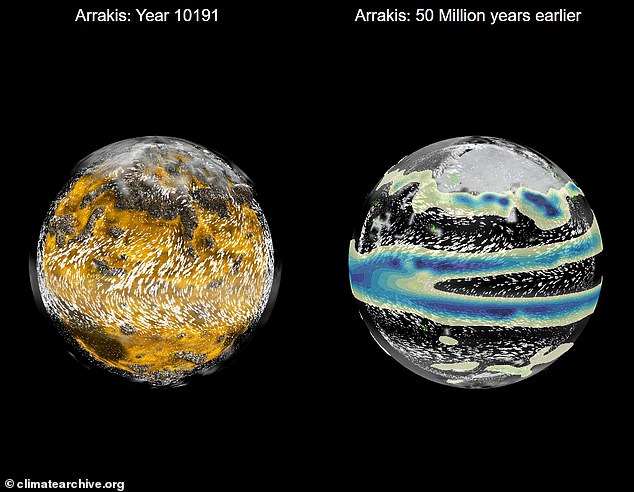
A simulation showed how the weather on Arrakis behaved in the year 10,191 (left), when the film is set, and how it behaved 50 million years earlier (right), before the planet was a desert.

A Fremen still suit contains a nose plug that collects the water vapor exhaled by the wearer. That fluid is then filtered and collected in a bag, where it can be consumed from a tube
Whenever a tribe member (or an enemy) dies, the body’s water is extracted and poured into the vast pools sacred to the Fremen.
They predict that one day a leader will emerge who can use this water to restore the planet’s once-rich plant life.
Even within the science fiction world of Dune, there is a logic to how this will happen. And it reflects the strategies scientists have for terraforming Mars.
One of the main similarities between Mars and Arrakis: vast reserves of water trapped beneath the planet’s surface.
In January, the Mars Express spacecraft revealed that a formation of frozen water is trapped inside the red planet.
This formation is three kilometers thick and, according to one estimate, if it were to melt, it could cover the planet with almost three meters of water.
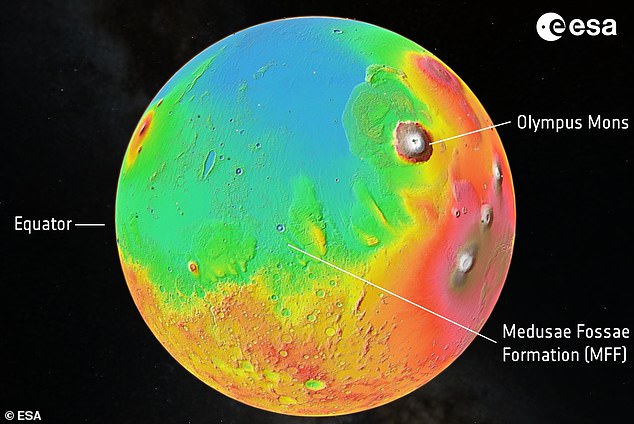
The water ice is located below the surface at the Medusae Fossae Formation, a large geological formation of volcanic origin near the equator of Mars
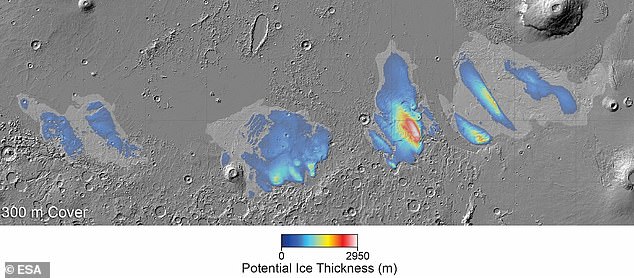
Map of water ice potential thickness in the Medusae Fossae Formation (MFF). The water ice deposits are up to 3.7 km thick
But covering the planet with water is not enough.
Unlike Earth, Mars has no magnetosphere.
This electromagnetic field surrounds our planet and protects us from most of the sun’s radiation.
Without it, the sun’s rays would evaporate all the moisture from the planet. So even if we could somehow melt this equatorial water, it would simply evaporate into space.
And that’s exactly what happened to ancient Mars, which, like Arrakis, was once full of flowing water.
So one strategy for terraforming Mars would involve creating an artificial magnetosphere.
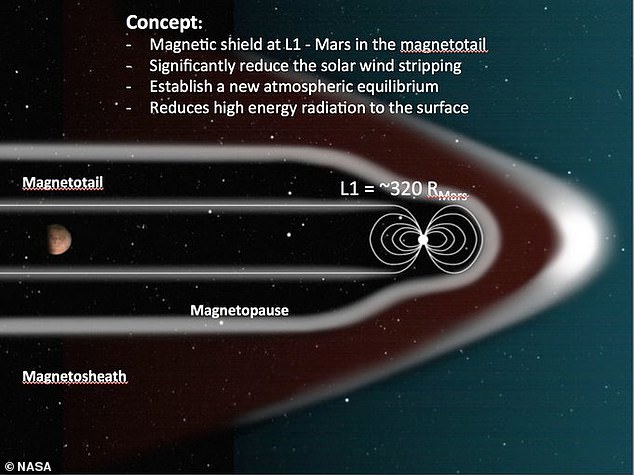
The now retired scientist proposed covering the Red Planet with a giant magnetic shield to protect it from the Sun’s high-energy solar particles
This is exactly what retired NASA chief scientist Jim Green had in mind when he proposed that a giant magnetic shield could allow humans to inhabit the planet.
‘Yes, it is doable. Stop stripping, and the pressure will increase. Mars is going to terraform itself,” Green told The New York Times.
‘The higher temperature and pressure allow you to start growing plants in the soil.’
The process of making an uninhabitable planet suitable for humans can take generations, but simulations show that blocking solar radiation will restore Mars’ atmosphere in just a few years.
This would set off a whole chain reaction: the planet’s equator would start to warm and eventually the polar ice cap would collapse, releasing water into the atmosphere and onto land in the form of lakes, rivers and oceans.
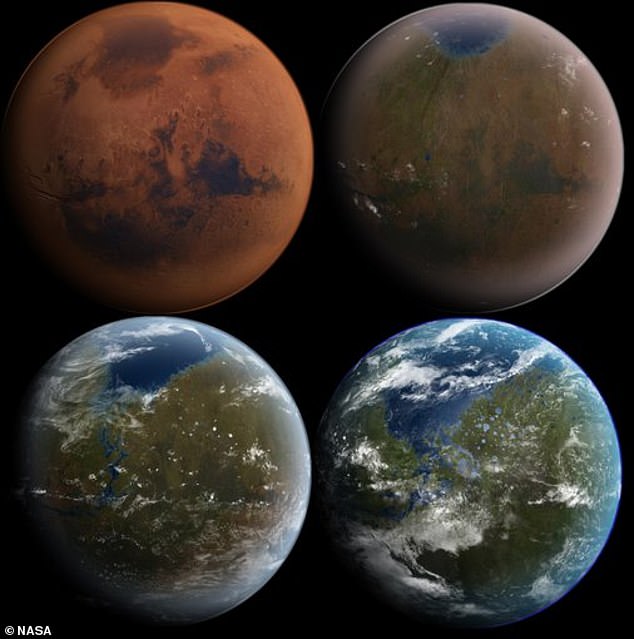
Some organisms could be bioengineered to extract certain gases from the Martian atmosphere – such as carbon dioxide and methane – and create nitrogen and oxygen. Shown are a series of possible steps if Mars were to undergo terraforming
Another strategy, explored by DARPA, involves using biology to our advantage.
There are numerous extant organisms that use chemosynthesis to survive. This means that they take chemicals from their environment to produce the necessary molecules of life.
For example, bacteria living near volcanic springs in the deep sea convert toxic hydrogen sulfide and methane into sugars that they use for energy.
If such microbes could be deployed on Mars, they could potentially consume the carbon dioxide and methane in Mars’ thin atmosphere to produce water, oxygen and possibly even edible carbohydrates.
This plan reflects part of the Fremen’s plan to terraform Arrakis.
Besides them, the other main inhabitant on Earth is a species of giant sandworm they call shai-hulud, which can grow to more than a mile in length.
These animals consume sand plankton, somewhat like land-dwelling whales. As they do so, they produce oxygen – sand contains the elements silicon and oxygen – making Arrakis’ atmosphere breathable.
There are, of course, some important differences between Arrakis and Mars.
Although Arrakis has a rugged environment, it is not completely uninhabitable.
A team of researchers in 2021 simulated the conditions on the planet as described in the novel and discovered that humans could indeed live there.
Dune part two ends without the terraforming plan coming to fruition, but in the sequel novels the Fremen slowly terraform the planet, beginning by planting small oases and developing technologies that can draw moisture from the air at night.
Their plan ultimately creates a climate on Arrakis in which people can walk around without a silent suit.
So if humans ever want to make Mars habitable for humans, it will likely be the result of many generations of work, with scientists dedicating their lives to a dream that most of them will never experience.
